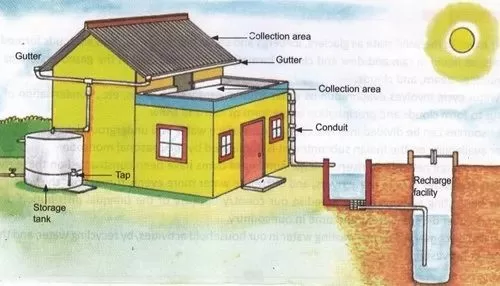Water harvesting is the collection and storage of rainwater for later use. It is a sustainable way to conserve water and reduce dependency on groundwater resources. This technique can be used in both rural and urban areas. Water harvesting can be done on a small scale, such as with a rain barrel, or at a larger scale, such as with a cistern.
There are many benefits of water harvesting, including:
- Reduces the demand for municipal water supplies.
- Helps to reduce flooding.
- Improves the quality of groundwater.
- Provides a backup water source during droughts.
- Can be used for irrigation, drinking water, and other purposes.
The basic principle of water harvesting is to collect rainwater from roofs, catchment areas, or other surfaces and store it in a tank or cistern for later use. The rainwater can then be used for a variety of purposes, such as irrigation, washing, and drinking.
There are many different types of water harvesting systems, each with its own advantages and disadvantages. Some of the most common types of water harvesting systems include:
- Rain barrels: These are small, above-ground tanks that are typically used to collect rainwater from roofs. Rain barrels are a popular option for homeowners who want to conserve water and reduce their water bill.

- Cisterns: These are larger, underground tanks that can store a significant amount of rainwater. Cisterns are a good option for businesses and homeowners who need a larger water supply.

- Infiltration systems: These systems allow rainwater to soak into the ground, where it can be stored in the soil. Infiltration systems are a good option for areas where there is a high water table.

Water harvesting is a valuable tool for water conservation and drought preparedness. It is a simple and effective way to collect and store rainwater for later use. Water harvesting can be used in a variety of settings, from homes and businesses to farms and communities.
Here are some of the specific ways in which water harvesting can be useful to our lives:
- It can provide a source of water for drinking, cooking, and bathing during times of drought.
- It can be used to irrigate crops, which can help to improve crop yields and food security.
- It can help to reduce the risk of flooding by capturing rainwater before it reaches rivers and streams.
- It can improve the quality of water by filtering out pollutants and sediments.
- It can help to conserve energy by reducing the need to pump water from wells or rivers.
Overall, water harvesting is a valuable tool that can help us to conserve water, reduce our reliance on other water sources, and improve the quality of our water.

